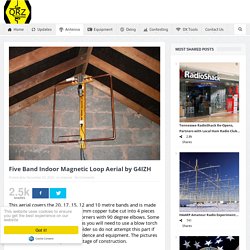

SCR522. Electronic 90V Plate Battery. Some readers of this page have asked me if I could turn this project (the simpler version) into a kit, including PCB.

I would like to get an idea how many people would like to buy such a kit. The price would be ca. 30-40 euro excl. shipment. If you would consider buying such a kit, please send me an email This page describes several circuits which convert a 6V battery voltage to 90V to replace the anode battery in battery operated tube radios. The final circuit does not produce any RF interference and has the special feature that it switches itself on and off! This page is in the first place intended to document this project for myself. The first version uses a small PIC microcontroller. All feedback is highly appreciated at: 1. This page starts with a short holiday trip that my wife, the children and I made to the lovely village of Old-Hastings in the spring of 2010. Figure 1.1 A selection of Plate/Anode batteries from the fifties-sixties [1]. “AA” cells take up a lot of space.
M17 Project. Bluepill Copies Code So You Don’t Have To. You really should learn to read Morse code.

But if you can’t — or even if you can, and just want a break — you can always get a computer to do it. For example, [jmharvey1] has a decoder that runs on a cheap Bluepill dev board. The device uses a touchscreen and a few common components. The whole thing cost about $16. You can see it at work along with a description of the project in the video below. The code uses the Arduino-style setup for the Blue pill — something we’ve talked about before.
The decoder table looks confusing at first until you realize that each “decode” value consists of a 1 as a start bit followed by a 1 for a dash and a zero for a dot. If you buy a Bluepill to make one of these, you might as well get two and build something to send code, too. Threeme3/QCX-SSB: This is a simple and experimental modification that transforms your QCX into a (class-E driven) SSB transceiver. Electric Radio Magazine - Electric Radio Magazine. WWII Aircraft Radio Roars To Life: What It Takes To Restore A Piece Of History. I’ve been told all my life about old-timey Army/Navy surplus stores where you could buy buckets of FT-243 crystals, radio gear, gas masks, and even a Jeep boxed-up in a big wooden crate.

Sadly this is no longer the case. Today surplus stores only have contemporary Chinese-made boots, camping gear, and flashlights. They are bitterly disappointing except for one surplus store that I found while on vacation in the Adirondacks: Patriot of Lake George. There I found a unicorn of historical significance; an un-modified-since-WW2 surplus CBY-46104 receiver with dynamotor. The date of manufacture was early-war, February 1942. My unconventional restoration of this radio followed strict rules so as to minimize the evidence of repair both inside and out yet make this radio perform again as though it came fresh off the assembly line. A Flavor of Radio for Every Need Somewhere in this menagerie of radio systems, you would find a CBY-46104 receiver. These radios were designed in the mid 1930’s. Websdr.org. Five Band Indoor Magnetic Loop Aerial by G4IZH.
This aerial covers the 20, 17, 15, 12 and 10 metre bands and is made from a single 3 metre length of 22 mm copper tube cut into 4 pieces of equal length and joined in the corners with 90 degree elbows.

Some plumbing skills are required here as you will need to use a blow torch with plumbers solder paste and solder so do not attempt this part if you do not have the required confidence and equipment. The pictures below show the full story at each stage of construction. The wide spaced tuning capacitor being used is a very old 200pF + 200pF type but the fixed vanes are connected in series, the moving vanes will not be connected at all therefore the capacitance can can be varied from about 7pF min to 100pF max.
The minimum capacitance is important as it is this that determines the highest frequency that the loop can be resonated at. The tuning capacitor is driven by a geared down motor which produces 2 rpm at 12 volts. XW1IC Laos by E21EIC The History of Coaxial Cable Ham College Episode 6.